| Aqir and Troll War | |||||||||||
|---|---|---|---|---|---|---|---|---|---|---|---|
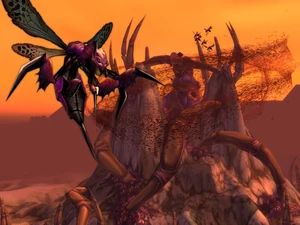 | |||||||||||
| Date | Around 16,000 years before the First War | ||||||||||
| Location | Old Kalimdor | ||||||||||
| Result |
Decisive troll victory | ||||||||||
| |||||||||||
| |||||||||||
| Previous | First war between the earthen and the iron dwarves | ||||||||||
| Concurrent | Burning Crusade | ||||||||||
| Next | The Great Purge | ||||||||||
The Aqir and Troll War[2] was a major conflict that occurred on Old Kalimdor, and was fought between a resurgent Azj'Aqir Empire and the newly-formed Empire of Zul, a coalition of the most powerful troll tribes. The war began around 16,000 years before the Dark Portal and saw the two races fight viciously for dominance of the continent.[3]
Having been seriously injured long ago in an encounter with the keeper Tyr, the C'Thrax known as Kith'ix went into a deep hibernation at the base of the Zandalar mountain range. Millennia later, his body was discovered by curious trolls who promptly conducted rituals and living sacrifices to reawaken what they believed was a loa. Awakening at these events and promptly slaying the trolls, Kith'ix made contact with the dormant aqir, who had remained hidden underground since the fall of the Black Empire. He ordered them to begin to build up their numbers, and they created a vast subterranean empire called Azj'Aqir. Finally prepared, the C'Thrax drove the aqir into a frenzy and urged them to lay waste to the bustling troll civilizations, with the goal of pleasing the Old Gods and to begin cleansing the world for their eventual return. The aqir swarmed the troll lands and began systematically destroying the majority of smaller tribes.
In response to this, the powerful Zandalar tribe created an alliance consisting of the trolls' largest tribes: the Zandalari, Gurubashi, Amani, and Drakkari. They dubbed this unified force the Empire of Zul and began to coordinate it against the encroaching aqir. Troll priests were even successful in enlisting the aid of the mighty Wild Gods to assail their enemies. Under the Zandalari's leadership, the trolls succeeded in halting the aqir offensive and began driving them back. Seeking to destroy the insectoids utterly, each troll tribe now began to hunt down aqir colonies and destroy them. To this end, many of the tribes ventured to different parts of the continent.
The Drakkari tribe went to the freezing north and engaged a large colony of aqir, who were bolstered by Obsidian destroyers captured from the titan stronghold of Ulduar. After much fighting, the Drakkari's ingenuity allowed them to finally defeat and crush their enemies. To the southwest, the Gurubashi tribe had also encountered the aqir as well as corrupted titan-forged. Having taken over the fortress of Ahn'Qiraj and enslaved its keepers, the aqir launched devastating attacks on the Gurubashi forces. At the direction of the Zandalari, the trolls began to divide their forces into more maneuverable groups and prosecuted an effective guerrilla war that brought the aqir armies to their knees. Meanwhile, the Amani had begun hunting the aqir's leader, who had retreated deep into the northeastern woodlands. Cutting through innumerable aqir, nearly all of the tribe flung itself in a suicidal assault on the C'Thrax. Although only a tiny fraction of the trolls survived, they succeeded in finally bringing down their mighty foe. This success made the Amani tribe legendary among the other troll nations.
Before long, the aqir, while not quite driven to extinction, were unable to continue the war and the trolls subsequently declared themselves the victors. The troll tribes, now far from their original home near the center of the continent, chose to settle in these new areas which they had discovered, founding new cities and empires such as Zul'Gurub, Zul'Aman, and Zul'Drak. The various remaining pockets of aqir, now confined to separate areas of the continent, branched off and developed their own cultures as they too formed new, individual empires. These included the mantid in the south, the qiraji in the southwest, and the nerubians in the north. The war, while destructive for both sides, firmly established the mortal, humanoid races as the rulers of the continent; although this would not be the last time the aqir and their descendants would attempt to dominate the land.[4]
History[]
The Rise of the Trolls[]
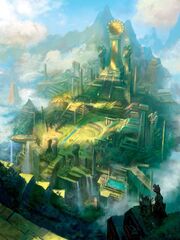
The Zandalari temple city of Zuldazar.
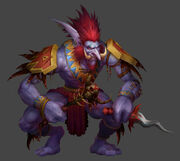
A normal troll
Millennia before the events of the First War, a relatively intelligent and sophisticated race of creatures emerged from the dense woodlands around the Well of Eternity and quickly proved extremely adept at surviving in their environment. Living as hunter-gatherers, this new race, the trolls, began to thrive in the surrounding forests. Although only possessing average intelligence when compared to Azeroth's modern races, the trolls had great agility and strength and their unique physiology allowed them to recover from physical injuries at an astonishing rate, even to the point of being capable of regenerating lost limbs over time. Over the years, troll society developed many superstitious customs, some practicing ritual cannibalism or devoting themselves to warfare. Some even sought mystical and arcane knowledge, often using meditation. A dark and powerful form of magic eventually developed among the burgeoning troll societies: voodoo.
An extremely spiritual people, all trolls, regardless of their path in life, held a deep reverence for Kalimdor's mysterious and elusive Wild Gods, powerful demigods that the trolls worshipped, calling them the 'loa'. In their devotion to their religious beliefs, the troll race gradually began to migrate to and gather around a series of great peaks and plateaus south of the center of the continent. This mountain range's importance lay in the fact that many of the trolls' honored loa resided here. The trolls ultimately named the sacred mountain range Zandalar and soon began to develop a civilization upon its slopes. The most powerful and spiritual group of trolls was known as the Zandalar tribe, and they laid claim to almost all of the mountain peaks and plateaus, considering them to be holy ground. Upon the highest peaks, they began to construct numerous shrines and temples for their deities. In time, these grew to become a bustling temple city known as Zuldazar and the other tribes united with the Zandalari.[5] Over time trolls from the lower castes of Zandalari society would leave to form their own new tribes.[6]
This period proved to be something of a golden age for the troll race; unchallenged by all but their brethren, the trolls began to expand in all directions. Eventually, although still not having expanded very far from Well of Eternity, various factions laid claim to a particular area, and territories were fully established. As the centuries progressed, several other tribes grew to rival the power and prestige of the Zandalari. The Gurubashi, Amani, and Drakkari all held large amounts of territories and, on occasion, even challenged the Zandalari in their position as the most powerful and influential of tribes. It was not uncommon for these powerful tribes to go to war with each other, usually over disputed territories or for specific resources. For the most part, however, these wars were benign and rarely lasted long enough for any major conflicts to occur. The trolls were so very skilled at hunting and fighting that any large confrontation would prove to be extremely costly for all parties involved, regardless of which side won. Untouched and unclaimed land was plentiful in every direction, and the various factions quickly realized that it was wiser to resettle or withdraw rather than to risk an open and potentially costly war.[7]
Kith'ix and the Aqir[]
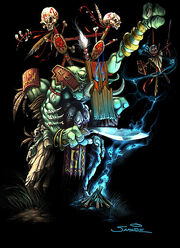
A troll mystic

A typical C'Thrax general, similar to Kith'ix.
There was only one location which the trolls were actively forbidden from disturbing by their priests and mystic. This was a dark mound of blackened earth and stone located at the base of the Zandalar Mountains. The loa warned troll priests of severe consequences should they disturb this place, and for centuries none dared to. Eventually, however, a group of curious and rebellious trolls led by the Gurubashi outcast Zan'do resigned to throw caution to the wind and plumbed the forbidden mound. What they discovered was that the black stones were not rocks—they were the jagged hide of a large and monstrous creature. Stunned and excited by their discovery, they incorrectly believed that what they had unearthed was a loa. They further concluded that this loa must be one of a particular power, as the other spirits appeared to be afraid of its presence. Determined to awaken this being, the trolls performed vile ceremonies and rituals, including living sacrifices. Roused by the ritually-spilled blood, a gigantic C'Thraxxi general emerged from its millennia-long slumber and immediately viciously slew those who had revived it.[8] Far from a loa, this being was Kith'ix, a being who had survived a major encounter with the keeper Tyr, many years prior. Gravely wounded from the event, the C'Thrax had fled southwestward to what would become known as the Zandalari Mountains, before collapsing into deep hibernation. Reeling from its presence, the ancient loa in the region buried the being beneath the earth so that, it was assumed, no other creature would disturb it.
The newly-awoken Kith'ix looked upon the troll civilization with contempt; it was but a pale shadow of the glorious Black Empire which had once laid claim to the world's entire landmass. The C'Thrax decided that it would be a fitting tribute to the Old Gods if these nations were reduced to ash. Kith'ix now reached out with his mind, seeking any of the Old Gods' servants who yet lived. It soon found a race of creatures it could control—the aqir. Since the fall of the Black Empire, these insectoids had remained hidden in small warrens and tunnels deep beneath the ground. Kithi'ix now rallied the dormant aqiri swarms, driving them to establish dominance over the continent once again. As the C'Thrax expanded its power and recovered, the aqir began creating a vast subterranean empire called Azj'Aqir. Observing these preparations patiently, Kith'ix watched as the aqiri ranks swelled in number. When its host was large enough, Kith'ix led them from their underground lairs and they swarmed across the land.
As the aqiri conquest began, many smaller troll tribes hopelessly fell before their tide. Although the trolls were skilled and formidable fighters, the aqiri threat was unique from anything they had faced before, and they did not know how to combat them effectively. Uninhibited, the vast insectoid legions pressed on, penetrating deeper and deeper into trolls lands. Before long, the aqir were encroaching the sacred Zandalar Mountains themselves, at which point the Zandalari moved to act. Through negotiations with the other tribes, the Zandalari united the three other most powerful ones into a single mighty force, which they named the Empire of Zul. The members of this newly-formed alliance would put aside past differences and transgressions and work together to end the aqir threat.[9]
The Empire of Zul[]
The Zandalari themselves took on the role of leading the united troll armies. From their strategic positions in the heights of the Zandalar Mountains, they could detect enemy movements and direct attacks at enemy weak points. This proved highly effective, and the trolls became able to consistently outmaneuver the more rigid aqir. Under the Zandalari's guidance, the other tribes began employing ambush tactics in the surrounding jungles and forests to whittle down the enemy's vast numbers, which would ordinarily allow them to overwhelm the trolls. Elsewhere, the tribes' priests summoned the formidable loa and beseeched them for their aid against the relentless insectoids. These ferocious Wild Gods joined the troll warriors in battle, ripping through the aqiri ranks and even managing to wound Kith'ix.
These new actions largely negated the majority of advantages that Kith'ix's army possessed. Unable to properly lay the mountains under siege, the aqir were forced to retreat from the area, suffering significantly from raids and guerrilla actions carried out by the Empire of Zul. Kith'ix, seriously wounded during an engagement with the loa, fled to the northeast with some of its most important aqiri followers. It planned to retire for a time to recover from its wounds, while the aqiri swarm continued its war against the trolls.[9]
Though the trolls had successfully driven the aqir away, the Zandalari were aware that they still posed a potent threat to the continued survival of troll civilization in the future. The insectoids, if left unchecked, would continue to attack outlying troll territories, and it would only be a matter of time before they once more regained to strength to assault the sacred mountains again; and so, at the Zandalari's behest, the other tribes moved out in force to hunt down the aqir. The trolls soon learned that it was not enough to simply defeat or kill the insects. If any escaped underground, they would establish a new colony, increase in numbers, and rise up again. To permanently end the threat, no corner of the continent could be left unguarded. To accomplish this difficult task, the Zandalari successfully convinced the most power-hungry of the troll factions to establish new and permanent strongholds across Kalimdor. At the forefront of these groups were the Gurubashi, Amani, and Drakkari tribes. After they had fully vanquished the aqir in their new regions, they could lay uncontested claim to the untouched fertile lands that they now lived in. The ambitious tribes listened to the Zandalari and readily agreed.
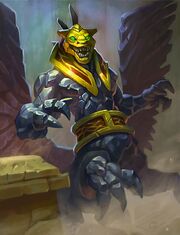
A dreaded obsidian destroyer
The Drakkari tribe acted first, pushing into the frigid and snow-covered north against a colony of aqir that had retreated in that direction. While they had expected to find numerous aqir, they were shocked and caught off-guard by the presence of corrupted tol'vir guardians. A small group of these titan-forged had been captured and enthralled from the nearby fortress of Ulduar. This particular type of tol'vir, known as Obsidian destroyers, caused havoc among the Drakkari ranks. Their size and stone skin allowed them to shrug off many conventional attacks, rendering them highly resistant to the trolls' normal form of warfare. The Drakkari were almost overpowered by these constructs, but they had evolved to become tenacious and brilliant in their thinking through years of combat. Eventually, the cunning fighters developed clever ways to knock over and shatter their foes, without suffering heavy casualties.
Meanwhile, the Gurubashi tribe had ventured to the southwest, where they too encountered corrupted titan forged. The trolls soon discovered that the aqir had overrun the ancient city of Ahn'Qiraj, originally built as a prison complex for the Old God C'Thun. When they seized the fortress, the aqir enslaved the resident guardians, the anubisath giants who guarded the prison. Early engagements between the two forces proved disastrous for the Gurubashi. The insectoids, along with their constructs, marched on and massacred several large troll forces and razed numerous encampments. Observing the situation, the Zandalari instructed the Gurubashi leaders to separate their tribe into smaller, more maneuverable raiding parties instead of large and easily-targeted armies. This new tactic allowed the Gurubashi to constantly bleed the aqiri forces over the years, whittling down their numbers while remaining impossible to effectively be attacked themselves. This worked extremely well and, although not quite able to wipe out the aqir completely, the Gurubashi were successful in securing uncontested control of the entire region.

Zul'Aman
Finally, the Amani tribe had set out to the northeast, their goal to hunt down and destroy the aqiri leader, Kith'ix. They tracked the C'Thrax's trail deep into the continent's northeastern woodlands, encountering increasingly fierce resistance the closer they came. After cutting through legions of aqir, the Amani finally reached the insectoid general itself. In a savage and legendary battle, virtually the entire tribe threw itself at Kith'ix and his remaining forces in a suicidal assault. The C'Thrax, though wounded from the war's previous conflicts, personally slaughtered countless trolls. Only a minute fraction of the tribe survived the terrible engagement, yet Kith'ix eventually succumbed to its tireless hunters. Though it had cost the tribe dearly, the reputation of the Amani became legendary among all the troll tribes for their heroic act. Atop the site where they had slain the C'Thrax, the Amani established a new settlement. In time, it would develop into the impressive temple city of Zul'Aman.
With Kith'ix gone, the aqir did not fight with the same level of ferocity and purpose. The war between the trolls and the aqir had shifted dramatically, almost unthinkably. Now, determined to never have to face the insectoids' relentless attacks again, the main objective of the trolls became their total extinction. Much brutal and bloody fighting continued for centuries between the two races, the aqir eventually becoming contained within the far northern and far southern reaches of the continent. Central Kalimdor was permanently scoured of their presence. The insectoids, now seeking simply to survive, greatly fortified their underground colonies against further troll aggression. They showed no further interest in fighting or encroaching on troll territories. In time, accepting the impossibility of ever truly wiping out the aqir, the trolls declared themselves the victors and laid claim to Kalimdor for themselves.[10]
Aftermath[]
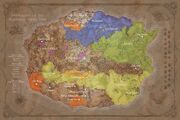
The new territories.
Without the war and imminent threat of destruction to bind them together, the troll nations grew ever more distant and insular from each other. The new territories which the tribes now ruled were very far from each other and so equated to relatively little interaction between the troll factions. Although successful in its one and only objective, the Empire of Zul as an idea now began to fade in relevance. The tribes' newly-established strongholds eventually blossomed into vibrant homes, temple cities, and ultimately the seats of empires in their own rights. The Zandalari, meanwhile, content with the outcome of the war and the general direction the troll race was taking, withdrew to their mountain plateaus and cities to pursue spiritual knowledge. Regardless, they would still maintain immense influence over the thriving yet disparate troll societies, having ensured the trolls' continued survival in their time of greatest need.[10]
Legacy[]

The mantid, a new race descended from the aqir
The aqir empire shattered, its insectoid members now existed in several pockets located throughout the continent. Isolated from the rest of their brethren, the aqir began to become more independent and each group started to develop its own culture and duties. Those in the north were drawn to the ancient underground prison of the old god Yogg-Saron. Owing to their proximity to the ancient being, these aqir began to gradually evolve into a new race, the nerubians. They would continue to rebuild in their new home, establishing the kingdom of Azjol-Nerub.
Similarly, those contained in the southwest of the continent inhabited C'Thun's prison of Ahn'Qiraj. They would make the prison-city's deepest reaches their home and, as a result of their exposure to C'Thun's presence, would slowly change to become the qiraji. Forgotten by the rest of the world, they would lie dormant under the ground, with the ever-present possibility that they may one day emerge and swarm once more. Finally, those aqir confined to the pocket of the southeast of Kalimdor congregated where the dead old god Y'Shaarj's essence still polluted the land. Like the other aqir, this particular old god's influence would gradually warp these insectoids into a unique race, the mantid. Even before the aqir empire had completely fallen, they had begun establishing a great colony known as Manti'vess, near the fabled Vale of Eternal Blossoms. From this base, the mantid would forge an empire of their own and, in the years following the aqir's fall, they would remain the most active—and dangerous— of the former aqir colonies.[11]
Notes[]
- At some point during the war, the C'Thrax Mythrax was tasked with invading the jungle region of Vol'dun on Zandalar.[1] He slaughtered the region's Zandalari and sethrak inhabitants until he was defeated by the loa Sethraliss (who gave her own life in the process), though not before Mythrax was able to destroy the disk at the heart of the great pyramid of Atul'Aman.[12]
References[]
- ^ a b The Lost Codex 2018-11-03. Blizzcon 2018 Interview: Alex Afrasiabi & Patrick Dawson - Story and Systems | The Lost Codex. YouTube. Retrieved on 2018-11-03.
- ^ File:Kalimdor Chronicle.jpg
- ^ World of Warcraft: Chronicle Volume 1, pg. 70 - 74
- ^ War of the Shifting Sands
- ^
 [Embellished Tusk Band]
[Embellished Tusk Band]
- ^ Vol'jin: Shadows of the Horde, pg. 200
- ^ World of Warcraft: Chronicle Volume 1, pg. 70 - 71
- ^ Word of the Conclave
- ^ a b World of Warcraft: Chronicle Volume 1, pg. 72
- ^ a b World of Warcraft: Chronicle Volume 1, pg. 73
- ^ World of Warcraft: Chronicle Volume 1, pg. 74
- ^
 [30-60] The Keepers' Keys
[30-60] The Keepers' Keys
